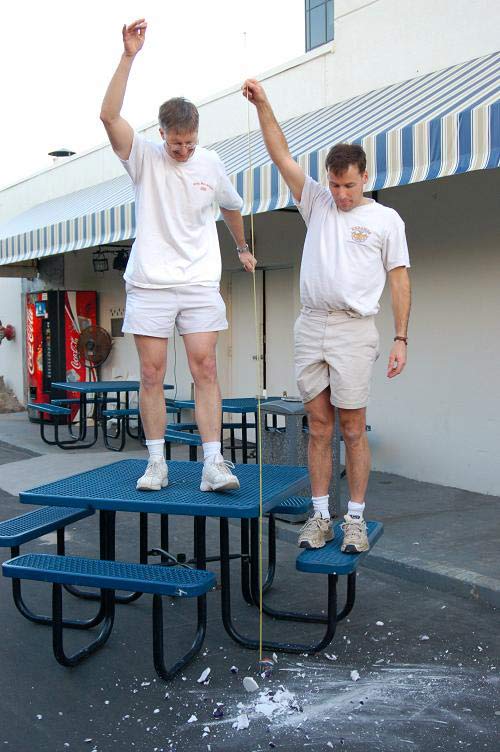The World's Toughest Coffee Cup

With a tape measure, a stepladder and an anxious crowd of ceramic students looking on, the official Mug Drop Contest recently shattered the dreams of indestructible chalices.
Meanwhile the winning cup, made of a tough ceramic composite by students from the University of Missouri-Rolla, left a dent in the pavement.
The long-established team crushed the competition—nearly 20 other undergraduate schools. Newcomers New Mexico Tech placed second with their clay cup.
The competition
Keramos, a fraternity of students studying ceramics, has sponsored the Mug Drop for more than two decades. This year’s competition was held at the American Ceramic Society’s annual meeting in Cocoa Beach, FL in January.
Entrants abide by a slew of rules. The mug must be made solely of ceramics, have a handle, and be fired to a minimum temperature of 572 degrees Fahrenheit.
To prove the materials aren’t toxic, students have to drink out of their mug in front of a judge before the drop.
Sign up for the Live Science daily newsletter now
Get the world’s most fascinating discoveries delivered straight to your inbox.
“A winning mug takes ingenuity, creativity and a really strong material,” said Keramos president Matt Dejneka, a materials scientist at Corning Incorporated.
Similar to a high-jump competition, contestants can pass on dropping their mug at shorter heights and enter at their chosen elevation. The contest starts with a dead-drop at 6 inches above ground, and increases in 6-inch increments to a maximum height of 12 feet.
To move on to the next drop, the mug mustn’t leak.
Brimming with strategy
New Mexico Tech took second place with a cup made of New Mexican stoneware clay and full of strategy. They designed a sacrificial bulbous bottom that broke on their first attempt, safely moving the protected inner-mug on to its next and final round.
But without the cushioning of the double bottom, New Mexico Tech couldn’t match the 12-foot drop of the University of Missouri-Rolla (UMR) mug. Jeff Rodelas and his UMR teammates entered the blue-ribbon mug that dropped unscathed. They depended on the tried-and-true mug design of their predecessors.
“Simplicity is the key. Every year we can rely on this design that can perform pretty well,” Rodelas told LiveScience. “We’re trying to come up with a way to make the mug better with new materials.”
The team made the hardy winning mugs out of aluminum oxide and zirconium oxide. Zirconium in another form, cubic zirconia, looks a lot like diamonds and is used in jewelry. Aluminum oxide makes a sturdy artificial hip. The zirconium oxide in the mug makes the aluminum oxide tougher to crack.
Now the group is looking at silicon dioxide fiber used on space shuttles for possible inclusion in future mugs.










